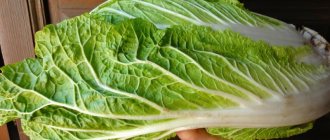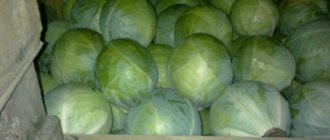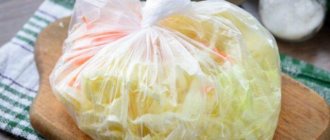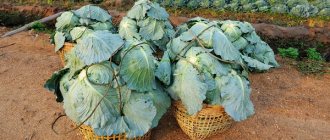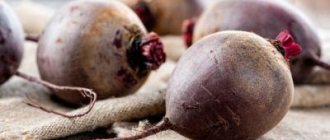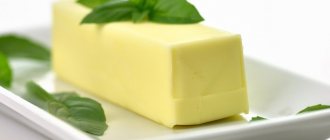Thanks to its taste and the presence of many beneficial micronutrients, Chinese cabbage has gained great popularity among lovers of vegetable dishes. Almost every woman uses it to prepare juicy and light salads. But after the cabbage ripening period ends, it’s time to harvest and store the crop. How to properly store this vegetable so that you can prepare various dishes with its addition in winter?
How to choose Chinese cabbage for storage
To prevent the vegetable you bought from quickly deteriorating during storage, it is recommended to select mid-late or late varieties grown in the Russian climate:
- Magician;
- Princess;
- Russian size;
- Half-headed;
- Asten;
- Vorozheya;
- Wineglass.
Harvesting of these varieties occurs from the end of September or mid-October. Cabbage leaves should not be frozen, otherwise it will quickly rot.
When choosing a vegetable, you need to pay attention to its appearance, since the possibility of its long-term storage depends on this:
- heads of cabbage are selected that are dense and uniform in color;
- the leaves should not show signs of pest bites or other defects.
Important!
Crushed or damaged leaves must be removed, as they can cause damage to the entire plant. If other heads of cabbage are adjacent, defects can spread to their leaves.
Can Chinese salad be frozen?
The cost of Chinese cabbage in winter is much higher than, for example, in summer or autumn. Therefore, cabbage can and should be frozen. It is better to do this immediately after harvesting. Fresh cabbage should be finely chopped, compacted into small bags, the air released from them and placed tightly in the freezer. In winter, it must be taken out in the required portions and, without defrosting, used for preparing various dishes, stewing, baking, etc.
For example, as a preparation for cabbage rolls. To prepare it, you need:
- carefully disassemble one or more heads of cabbage into individual leaves and pour boiling water over them;
- after this, use a sharp knife to remove the thick part of the sheet rods;
- dry them with a paper towel;
- then place in a plastic bag or plastic container.
- The leaves should be even and straightened so that they do not become deformed during freezing.
How to store Chinese cabbage at home
You can preserve the vegetable in different ways so that you can prepare dishes using it in the winter. In an apartment or house, it can be stored in the refrigerator, basement or on the balcony, while observing certain rules.
How to ferment Chinese cabbage
One of the most popular recipes for pickling vegetables is kimchi (Korean style). To ferment cabbage you will need additional ingredients:
- salt;
- sugar;
- onion;
- garlic;
- red pepper;
- water.
First prepare the brine. To do this, pour 1 tbsp into 1 liter of water. salt and place the container on the fire. Stirring constantly, you need to wait until the salt dissolves. Then the brine is removed from the heat and left to cool. At this time, the head of cabbage is freed from spoiled leaves and cut lengthwise for 4 hours, cutting out the stalk. The remaining leaves, the total weight of which should be 1 kg, are cut into thin strips. Chop 50-100 g of onion. The chopped vegetables are mixed in a saucepan or large bowl and poured with brine. The container is covered with a plate on top, on which a load is placed.
After 2 days, take out the pekin leaves and grease them with pre-prepared seasoning (mix 2 tablespoons of ground red pepper, juice of 6 cloves of garlic, 1 teaspoon of sugar). After this, the cabbage is again placed in a container with freshly prepared brine under pressure for 2 days. The prepared sauerkraut can be placed in screw-on jars and left in the refrigerator, or the container can be taken without pressure to the basement.
Pickling cabbage can be done without additional ingredients. They are used to improve taste. The most suitable for Beijing are dill, parsley, bay leaf, pepper and cloves.
How to dry cabbage
Drying whole heads of vegetables is not recommended. The prepared leaves are cut into strips of 3-5 mm and placed in the oven (60-90 degrees) or electric dryer (55-60 degrees). In the first option, the drying time is 4 hours, in the second – 5 hours.
For storage, the leaves are placed in linen bags.
Storing cabbage in a vegetable storehouse, basement, cellar, or balcony
Basic steps when storing Pekinka in vegetable stores:
- all heads of cabbage are placed in a plastic bag or box, placing them horizontally in 3 layers, while the forks should not fit too tightly to each other;
- the storage container is not tightly closed to provide the cabbage with sufficient ventilation (without drafts);
- The humidity in such a room should be at the level of 96-98%. At lower rates, the leaves will begin to dry out, since they do not have a waxy layer that protects against excessive evaporation. And at 100% humidity, the heads of cabbage will rot in a week;
- the air temperature is maintained at a level from 0 to +3 degrees.
Under these conditions, forks can be stored for 4 months. At temperatures from -3 to +3 this period is reduced to 16-20 days, and at temperatures above +4 degrees – to 2-4 days.
In a cellar or basement, the vegetable is stored in a box with damp sand, into which its roots are buried. Another method of storage in such rooms is to hang cabbage upside down on a cable. In this case, the forks are hung at a sufficient distance from each other, otherwise rot will begin to arise at the points of contact.
For long-term storage, cabbage should be wrapped in cling film, and it will remain unspoiled for 3 months. Humidity levels can be reduced slightly.
If you live in an apartment, then a loggia or balcony is suitable for wintering vegetables, where the temperature during the entire storage period is in the range from 0 to +5 degrees. Direct sunlight should also not hit the cabbage.
Storage rules on the balcony:
- remove spoiled leaves and dirt;
- Place each fork in a linen bag or food-grade plastic bag. You can wrap it in 2-3 layers of cling film, leaving a small hole near the stalk;
- the heads of cabbage are laid horizontally in wooden boxes (maximum 3 layers);
- Every 2 weeks the forks are checked for rot. If such a head of cabbage is found, it is removed from the total mass so that they do not spoil. They also remove all defective leaves and change the packaging material.
Following these rules will allow you to preserve cabbage for 90-100 days.
How to store Chinese cabbage in the refrigerator and freezer
If you need to store a small number of heads of cabbage, then the refrigerator is suitable for this. They must first be inspected and all damaged leaves removed. Then the cabbage is wrapped in cling film to prevent condensation from appearing on it, and placed in a vegetable compartment or plastic container, which is tightly closed. This method allows you to extend the life of the vegetable by 1 month. Periodically you need to check that the leaves have not deteriorated or dried out.
To store in the freezer, cabbage is cut into strips and placed in small portions in plastic bags. Many people recommend pre-blanching the leaves (dipping them in salted boiling water for 3 minutes). Then they should dry on a paper towel. This will reduce the risk of nitrates entering the body. This method of preparing vegetables for the winter is suitable for preparing stews, salads and soups.
If you like cabbage rolls, then the pekinka can be frozen with whole leaves. The head of cabbage is carefully disassembled into individual leaves, which are steamed in boiling water for 10 minutes. Then, using a sharp knife, cut off the thick stem and leave them to dry on a towel.
After completing these steps, the well-flat leaves are placed in a plastic container or plastic bag and placed in the freezer. In this form, cabbage can be stored for 4 to 7 months.
Important! It is recommended to freeze in small containers so that when preparing a dish you can use all the defrosted product. Putting it in the freezer again will result in loss of flavor.
other methods
Peking cabbage does not have to be stored fresh , taking up large spaces for drawers and hanging shelves. The harvest is used to make delicious canned food, and is also frozen and dried.
Freezing
Before freezing, the leaves are carefully inspected and the head of cabbage is cut , since insect pests often take root inside. Further:
- The vegetables are washed in cool water.
- Immerse in salted boiling water for 1 minute.
- Blanched leaves are placed on a towel and dried.
- Cabbage is chopped or sent to the freezer with whole leaves, wrapped in film or placed in plastic containers.
The frozen semi-finished product is used for hot dishes, casseroles, as a filling for pies and dumplings.
Drying
An electric dryer or oven is suitable for this . The head of cabbage is cut in half, inspected for the presence of pests inside and chopped. The resulting mass is laid out in one layer on a baking sheet or a special stand and sent to dry at a temperature of 70-80°C for 4-5 hours.
Periodically, carefully turn the cabbage over. The finished product is laid out in paper or linen bags and sent to a dry place (for example, kitchen cabinets or pantry).
Canning
It is not advisable to ferment Chinese cabbage ; its leaves quickly become soft under the influence of salt, sugar, vinegar and other ingredients. Because of this, the main advantage of the product is lost - crunchiness. However, a prepared marinated dish will always come in handy in winter.
For canning, take a set of products:
- 0.5 kg cabbage;
- 0.5 tbsp. vinegar;
- 40 g sugar;
- 3 tbsp. l. salt;
- a few peas of allspice;
- half a pod of hot pepper;
- bay leaf and cloves - optional.
Cooking procedure:
- The head of cabbage is washed well under running water.
- Chop into strips 4-5 cm long.
- Place in sterile jars, lightly compacted.
- In a separate bowl, boil 0.5 liters of water, add spices and add vinegar at the end of cooking.
- Fill jars with cabbage with boiling marinade, seal them hermetically and wrap them in a blanket for 24 hours.
How long can Chinese cabbage be stored?
The wintering period of vegetables depends on the temperature and humidity in the storage room. The optimal humidity level is 97-98%. When it decreases, the leaves will begin to dry and wither, and when it increases, they will rot.
To preserve cabbage for 3 months. the temperature must be kept at a level from 0 to +3 degrees. If it increases to +4 and above, the vegetable will begin to sprout and it is advisable to eat it in a few days. When the temperature ranges from -3 to +3, cabbage is stored for no longer than 20 days. The vegetable can be kept in the freezer for more than 3 months.
An important storage condition is also to place the heads of cabbage in a dark, well-ventilated and cool place.
Shelf life
A high-quality and unspoiled harvest can be stored for 4-5 months . Temperature changes, high humidity, and non-compliance with ventilation conditions significantly reduce the storage period.
The product is stored in the refrigerator for no more than 1 month , regularly inspecting it and changing the packaging cling film with damaged upper leaves.
How to keep it fresh until the new year
To pamper loved ones and guests with fresh salads on New Year's holidays, Chinese cabbage is stored in the cellar, in boxes with wet sand . This is how the heads of cabbage retain their taste, beneficial properties and presentation.
How to store Chinese cabbage
Various types of containers are suitable for wintering vegetables:
- freezer;
- plastic containers with a tight-fitting lid;
- food plastic bags or film;
- linen bags;
- glass jars or pan (pickling);
- wooden boxes in which the heads of cabbage are separated from each other by polyethylene liners.
The container is selected depending on the storage method.
Storage methods
Depending on the capabilities, each housewife chooses the most optimal way to store the crop. For this purpose, ordinary available means and devices are used.
In paper
For wrapping, use regular newspaper or sheets of office paper . Each head of cabbage is wrapped in 2 layers so that there are no uncovered areas left. The paper prevents the heads from touching, provides sufficient thermal insulation, and also protects the cabbage from light and moisture.
In sand
For maximum long-term storage, the Peking plant is dug up along with the root part , trying not to damage it. The heads of cabbage are lightly compacted in boxes with sand so that it covers the root and part of the stalk. This storage method is suitable for cellars and balconies. The sand is periodically moistened to keep the leaves fresh.
In boxes
Absolutely dry and not rotten heads of cabbage are placed in wooden boxes or special containers with the stalk up. A mound of no more than 3 rows is allowed; each copy is wrapped in cling film or plastic wrap.
Periodically, vegetables are inspected and rearranged , changing places, to prevent squeezing the sides of the heads of cabbage and the appearance of mold. The boxes must have holes for air access.
In limbo
If there is not enough space in the cellar, a wooden shelf is installed above the arranged boxes of vegetables or nailed to the ceiling . Each head of cabbage, wrapped with rope by the stalk, is attached separately to the nails driven into it. When harvesting, leave at least 3 cm of the stalk.
In this state, vegetables are stored well due to sufficient ventilation. It is convenient to inspect them to identify signs of rot and mold.
Errors
The main mistakes housewives make when preparing cabbage for storage:
- You can’t put vegetables in the same container or next to apples and bananas. They produce ethylene, so cabbage leaves will spoil quickly;
- packing the crushed leaves into a storage container;
- chopping causes moisture loss;
- removing a large number of leaves from the head of cabbage.
Such actions will accelerate the withering of the product and reduce its shelf life.
Selecting the best varieties for winter storage
This point should be considered even at the stage of planting Beijing in the spring, since the fruits of the vegetable, depending on the varietal variety and ripening period, have different shelf life. Thus, everyone’s favorite juicy and tender early ripening hybrids are not suitable for storing at home for the winter - they quickly deteriorate (lose moisture, taste, wither and rot).
Important! When choosing a variety of Chinese cabbage for storage, give preference to domestic hybrid varieties, since their selection took into account the conditions of the growing environment.
Early ripening hybrid varieties of Chinese vegetables are most often planted for preparing salads, soups, and purees in the summer. When fresh, such fruits will last no more than a week. The only way to preserve them for the winter is through canning (various salads and assorted vegetables).
Due to such features, these varieties are rarely used on an industrial scale. Gardeners plant a small number of such plants on their plots. Experienced vegetable growers advise selecting for storage the best fruits of mid-ripening and late-ripening varieties (ideally late-ripening).
These include:
- Turquoise;
- Market;
- Mojito;
- Nick;
- Orange heart;
- Magician;
- Fortune teller;
- Russian size;
- Wineglass;
- Half-pumped;
- Asten;
- Nozaki.
The shelf life of the listed varieties with the right approach lasts 3-4 months. The shelf life of mid-season varietal varieties is slightly shorter - up to 3 months. These types include Spring Beauty, Hydra, Grenade, Janine, Princess, Custard, Tenderness, Kiseki, Miss China, Philippok, Modern, Richie, etc.
Adviсe
You can increase the wintering duration of cabbage by following some rules:
- there is no need to leave the vegetable in a sealed bag, it needs good ventilation;
- The storage area should not be illuminated or exposed to direct sunlight;
- maintain a certain level of temperature and humidity in the room where the cabbage is located;
- periodically check the leaves for defects and rot;
- exclude the proximity of bananas and apples;
- Before packing into a storage container, the cabbage must be dried;
- When the first signs of wilting appear, it is recommended to consume the product.
Having learned about ways to store such a healthy vegetable, you can prepare dishes with its addition not only in the warm season of the year. Follow all storage rules, which will help the cabbage retain its freshness and taste for many months to come.
Recommendations
To ensure maximum shelf life of Chinese cabbage, it is recommended to follow these practical tips:
- If you store heads of cabbage, then you cannot remove the limp, wilted foliage. On the contrary, Chinese cabbage is stored even better in it. The surface layer will serve as a natural “packaging”.
- Even if all storage conditions are provided, it is recommended to periodically inspect the heads of cabbage and turn them over to avoid the appearance of rot.
- If the cabbage begins to wilt, this is quite normal. This product is completely shelf-stable, but should be consumed faster.
- To preserve whole heads of cabbage for as long as possible, it is better to put them in a basement or cellar. Moreover, it is advisable to wrap each one in a paper bag or newsprint.
